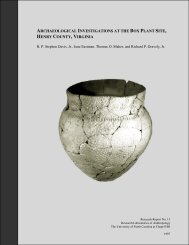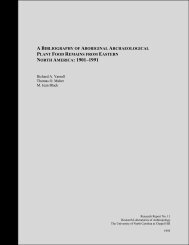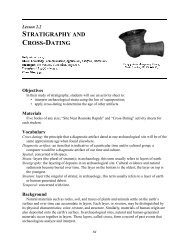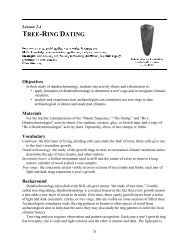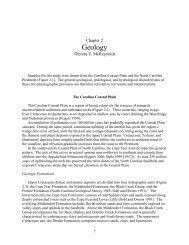Download pdf version - 42.3 MB - Research Laboratories of ...
Download pdf version - 42.3 MB - Research Laboratories of ...
Download pdf version - 42.3 MB - Research Laboratories of ...
Create successful ePaper yourself
Turn your PDF publications into a flip-book with our unique Google optimized e-Paper software.
In 1893 the University attempted to supply running water from a large well pumped intoholding tanks in the attic <strong>of</strong> South Building, but this did not meet requirements (Battle1912:570–571). In 1901 the University completed their first water works and sewage system:Steam pumps were put up on Bowlin’s Creek, about one and a half miles fromthe Campus, from which the water was forced into a l<strong>of</strong>ty tank, from which itdescends by gravity to the places needed [Battle 1912:571].In 1903 the buildings were provided with sanitary conveniences such as “Bathtubs, showerbaths, closets” (Battle 1912:511).The town, however, had to wait longer for a water system. They had long relied ontwo wells, one in front <strong>of</strong> the Methodist Church, and the other on the corner <strong>of</strong> Franklin andColumbia streets. “The town installed pumps in both in 1904” (Vickers 1985:102). The“entire community, business and residential, [was] dependent on privies until sewer lineswere installed in 1906” (Vickers 1985:102). Thus, the hotel may never have had runningwater and bathrooms before its sale to the University in 1911. The bathroom in the shedattached to the Phi Delta Theta fraternity house looks like an afterthought (the shed is drawnin on the 1911 insurance map [see Figure 10], and is visible in the 1919 aerial photograph[see Figure 15]), and the house may have been hooked up to the sewer lines some time after itwas built (The house was probably built some time after Coxe’s purchase <strong>of</strong> the property in1908 – see Historical Background above).In addition to the ceramic chamber pots, washbasins, and ewers, one base fragment <strong>of</strong>a ceramic shaving creme container was recovered, marked “SHAVING CREME”. ..“PREMIUM”.Toothbrushes. Fourteen toothbrush fragments, representing at least 12 toothbrushes,were recovered from the site (Figure 48a–g). This number seems large in comparison to theoccurrence <strong>of</strong> other grooming aids. Only two comb fragments were found (Levels 2 and 4,northern part <strong>of</strong> the site), and no hair brushes were recovered. All but one <strong>of</strong> the toothbrusheswere found either north or south <strong>of</strong> the fraternity house (one was found within the walls <strong>of</strong>the fraternity house), and all but one came from Levels 1 and 2.Nine <strong>of</strong> the toothbrushes were bone, and one was marked “L’Elegante.” The onewooden toothbrush was marked “COWARD & WOOTEN.” There were two plastictoothbrushes, one <strong>of</strong> which was marked “PATENTED OCT 21, 1884”. . .“AUG. 8, 1899”. ..“The Prophylactic”. . .“Florence Mf’g. Co.”. . .“MEDIUM”. . .“6”. It seems likely that many<strong>of</strong> these toothbrushes were associated with the fraternity house, while some <strong>of</strong> the bone onesin the northern part <strong>of</strong> the site, where there seems to have been a cache <strong>of</strong> six <strong>of</strong> them, maybelong to the hotel context. The ones south <strong>of</strong> the fraternity house were found near thepossible dental tool (see above).Glass – Cosmetics/Toiletries. Cosmetic and toiletry glasswares make up a very smallpercentage <strong>of</strong> the total glass from the site (Table 4). Fragments from positively identifiedvessels in this group add up to a count <strong>of</strong> 18 out <strong>of</strong> a total glass count <strong>of</strong> 5,785, or one third <strong>of</strong>one percent <strong>of</strong> the entire assemblage. The forms represented are shaving creme containers,54



